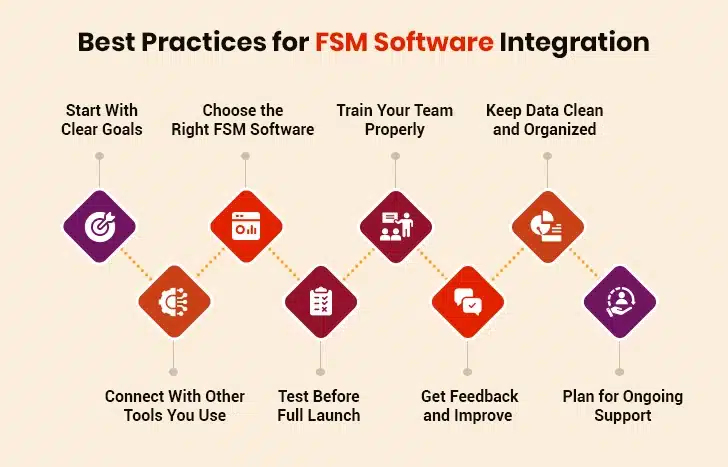Efficient field service management cannot be ignored in the dynamic world of service-oriented companies that aim to ensure customer delight, maximize productivity, and optimize resources. Field Service Management (FSM) software is one of the most powerful tools to streamline operations, improve communication, and provide real-time visibility into field activities. Businesses leveraging field services utilize diverse software solutions like scheduling and routing software, accounting, work order management systems, ERP, and various others. The successful implementation of FSM software depends on its seamless integration with existing systems within an organization.
According to Grand View Research, from 2023 to 2030, the global market of field service management is expected to grow at a CAGR of 13.3%. 77% of field service organizations use on-premises FSM solutions. Hence, the effective integration of an FSM solution with other business systems is crucial. In this blog post, we will understand the challenges in field service management software integration with the existing systems. The post also explores the key features and benefits of FSM software. Lastly, it delves into the best practices for successful FSM software integration.
How to Choose the Right Field Service Management Software
Table of Contents
Business Significance of Field Service Management Software
FSM Software Integration Challenges and How to Overcome Them
- Different Data Formats and Standards
- System Upgrades and Compatibility Issues
- Data Security Concerns
- Change Management and User Training
Field Service Management Software: Key Features and Benefits
Business Significance of Field Service Management Software
Designed for automating and streamlining end-to-end field processes, FSM software includes scheduling and dispatching, word order tracking, inventory management, and real-time communication between the field and the office. A comprehensive field service management solution assists in workforce optimization and is important in increasing operational efficiency, reducing response time, and enhancing customer satisfaction.
If you want to harness the potential of FSM software, it is vital to ensure that it integrates seamlessly with existing systems such as ERP, CRM, and other crucial business applications. This guarantees an integrated view of operations, prevents data silos, and allows organizations to make critical decisions with the help of real-time insights.
Streamline Your Field Services – Request a Free Demo Today!
FSM Software Integration Challenges and How to Overcome Them
While there are multiple advantages of implementing FSM software, its full potential can only be realized when it is seamlessly integrated with an organization’s existing systems. Integration helps in the seamless data flowbetween different departments, promoting a holistic view of operations and fostering effective decision-making. However, achieving this level of integration is not an easy task and organizations encounter various field service management challenges in the process.
Here are some common integration challenges faced by organizations and the solutions to overcome them:
Different Data Formats and Standards
One of the key challenges in integrating field service management software with existing systems is the differences in data formats and standards. Different systems might employ different data structures, making it tough to establish a coherent link. A seamless integration process depends on standardizing data formats and guaranteeing compatibility amongst systems. This challenge gets exacerbated while dealing with legacy systems that are unable to conform to modern data standards.
Solution
To overcome this challenge, organizations must invest in middleware solutions that can serve as links between multiple systems. This will facilitate data translation and transfer in a format that is well-suited for both FSM software and existing systems. Also, going for industry-standard data formats can improve interoperability and streamline integration processes.
System Upgrades and Compatibility Issues
Updates and upgrades are made to the FSM software and the existing systems as technology advances. Keeping software versions compatible with one another can be quite challenging. Incompatibility issues can result in system crashes, data inconsistencies, and workflow instructions, counteracting the advantages of the FSM solution.
Solution
When it comes to system upgrades and maintenance, organizations must take a proactive stance to overcome this challenge. Updating the FSM software and existing systems regularly ensures their continued compatibility and seamless communication. Also, it’s vital to stay informed about upcoming updates and plan their integration strategies appropriately, organizations need to establish open lines of communication with their FSM software providers.
Data Security Concerns
Data security concernsare valid when integrating FSM software with existing systems. Field service operations employ sensitive information such as payment transactions, customer details, and service logs. Any breach in the process of integration can expose this data to unauthorized access, resulting in serious consequences.
Solution
Organizations must implement powerful access controls and encryption protocols during the process of integration to address the concerns of security. Carrying out regular assessments and security audits can assist in identifying vulnerabilities and ensuring compliance with the regulations of data protection. Working with field service management solution providers that follow industry best practices and prioritize security is important in safeguarding sensitive information and empowering field operation teams.
Change Management and User Training
Introducing field service management software in the organization and integrating it with existing systems generally calls for a change in the way employees work. Reluctance to adapt and a lack of understanding of the new technology can affect the successful implementation of an integrated solution. Offering in-depth training programs and promoting a culture of adaptability are critical components in overcoming this challenge.
Solution
Organizations must invest in comprehensive training sessions for employees to acquaint them with the new FSM software and the integrated systems. Additionally, effective change management strategies such as clear communication about the advantages of the integrated solution, can help lessen resistance and promote a seamless transition.
Field Service Management Software: Key Features and Benefits
FSM software simplifies how companies handle fieldwork. From scheduling jobs to keeping customers updated, it saves time and reduces mistakes. Check out the key features and benefits that make it useful for any business with a mobile team.
| Feature | What It Does | How It Helps |
|---|---|---|
| Job Scheduling | Helps plan and assign tasks to field workers | Saves time by organizing tasks efficiently |
| Real-Time Tracking | Shows where field workers are on a map | Helps manage jobs better and respond faster |
| Mobile Access | Lets workers update job details from their phones | Reduces paperwork and keeps information up-to-date |
| Customer Updates | Sends automatic alerts to customers about appointments | Improves customer satisfaction with clear communication |
| Inventory Management | Tracks tools and parts used for jobs | Prevents delays by ensuring workers have what they need |
| Reporting | Creates summaries of work done and time spent | Helps spot problems and improve future work |
| Billing & Invoices | Automates billing based on work completed | Makes payments faster and reduces errors |
Best Practices for FSM Software Integration
Getting your field service software to work well with other systems takes careful planning. These proven methods help everything connect smoothly so your team can work without hiccups.
I. Start With Clear Goals
Before bringing in the best field service management software, know exactly what problems you want to solve. Do you need to track your field workers better? Reduce delays in jobs? Make customer service faster? Write down these goals clearly. This helps you pick the right FSM software. Without clear goals, you might end up with tools that don’t help your business. Think about what success looks like; maybe it’s finishing jobs faster or getting fewer customer complaints. Keep these goals simple and realistic so you can assess growth.
II. Choose the Right FSM Software
Not all small business field service management software works the same way. Some are made for big companies, others for small teams. Pick one that aligns with your business. Look for simple features that match what your team actually needs. The FSM software should make daily tasks simpler, not add extra steps. Take time to compare options and maybe try a demo before deciding. The right choice will save time and reduce headaches later.
III. Train Your Team Properly
FSM software only helps if your team knows how to use it well. Don’t just give them a quick demo of FSM software, instead provide complete training. Show how it makes their jobs easier, like saving time on paperwork or helping them find job locations faster. If people understand the benefits, they’ll use it better. Include everyone who will use the system, not just managers. Offer follow-up training for those who need it. Good training reduces mistakes and helps your team feel confident with the new tools. When people know how to use the field management service software correctly, work gets done correctly and with fewer problems.
IV. Keep Data Clean and Organized
FSM software needs clean data to work well. Before moving your customer details, work orders, or schedules to the new system, take time to clean them up. Remove old or duplicate entries, fix spelling mistakes, and make sure all information is complete. Imagine trying to find a customer’s address when it’s entered three different ways. This may cause delays and mistakes. Clean data helps your team work faster and makes the FSM software more reliable. Set simple rules for how data should be entered going forward, so everything stays organized. This small step saves lots of time later.
V. Connect With Other Tools You Use
Your small business field service management software shouldn’t work alone. It needs to connect with other tools your business uses every day. When systems connect, information flows automatically. This means no need to enter the same details repeatedly. Check if the FSM software can work with your current tools before buying it. If they don’t connect, you’ll waste time and likely make errors moving information between systems. Good connections make everything smoother for your team and give you better reports about your business.
VI. Test Before Full Launch
Never make a transition to field management service software all at once. Start with a small test group, maybe just a few team members or one location. Let them use it for real jobs while others keep working the old way. Watch what goes well and what problems come up. This test run helps you spot issues before they affect your whole business. Fix any problems, adjust settings, and make sure everyone understands how to use it properly. When everything works smoothly for the test group, roll it out to everyone else. Taking this time upfront prevents big headaches later.
VII. Get Feedback and Improve
After your team starts using the FSM software, ask them what’s working and what’s not. Talk to field workers, dispatchers, and managers to know their honest opinions. Maybe some features are confusing, or certain tasks take longer than before. Take this feedback seriously and work with your software provider to fix issues. Perhaps, you may need to change some settings or provide training. Small tweaks can make a big difference in how well the system works. Remember, FSM software should adapt to your business, not the other way around. Keep improving it based on real user experiences.
VIII. Plan for Ongoing Support
FSM software will always have questions and issues that pop up later. Make sure you have a plan for getting help when needed. This could mean training someone on your team to handle basic problems or knowing who to call at the software company for bigger issues. Keep all login credentials and support details in one place. Also, plan for regular updates as the FSM software gets better over time. This helps to take advantage of new features and fixes. Good support means your team won’t get stuck when they encounter problems down the road.
Transforming FSM Software with Generative Artificial Intelligence
Conclusion
For organizations looking to optimize their field service operations, integrating with existing systems is a challenging but important task. A successful integration process calls for addressing challenges concerned with data formats, security, compatibility, and user adoption. Even while the journey may be tough, the advantages such as increased productivity, better decision-making, and higher levels of customer satisfaction make the effort worthwhile. A strategic approach, together with the right technology partners and a dedication to continuous optimization, can help organizations navigate the integration process and promote a seamless and connected future in field service management.







